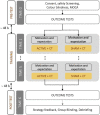Older adults with lower working memory capacity benefit from transcranial direct current stimulation when combined with working memory training: A preliminary study
- PMID: 36299611
- PMCID: PMC9589058
- DOI: 10.3389/fnagi.2022.1009262
Older adults with lower working memory capacity benefit from transcranial direct current stimulation when combined with working memory training: A preliminary study
Abstract
Aging is a very diverse process: successful agers retain most cognitive functioning, while others experience mild to severe cognitive decline. This decline may eventually negatively impact one's everyday activities. Therefore, scientists must develop approaches to counteract or, at least, slow down the negative change in cognitive performance of aging individuals. Combining cognitive training and transcranial direct current stimulation (tDCS) is a promising approach that capitalizes on the plasticity of brain networks. However, the efficacy of combined methods depends on individual characteristics, such as the cognitive and emotional state of the individual entering the training program. In this report, we explored the effectiveness of working memory training, combined with tDCS to the right dorsolateral prefrontal cortex (DLPFC), to manipulate working memory performance in older individuals. We hypothesized that individuals with lower working memory capacity would benefit the most from the combined regimen. Thirty older adults took part in a 5-day combined regimen. Before and after the training, we evaluated participants' working memory performance with five working memory tasks. We found that individual characteristics influenced the outcome of combined cognitive training and tDCS regimens, with the intervention selectively benefiting old-old adults with lower working memory capacity. Future work should consider developing individualized treatments by considering individual differences in cognitive profiles.
Keywords: individual differences; non-invasive brain stimulation (NIBS); older adults; plasticity; tDCS—transcranial direct current stimulation; working memory training (WMT).
Copyright © 2022 Assecondi, Hu, Kroeker, Eskes and Shapiro.
Conflict of interest statement
A patent application has been submitted by the University of Birmingham and Dalhousie University with SA, KS, and GE named as inventors. The remaining authors declare that the research was conducted in the absence of any commercial or financial relationships that could be construed as a potential conflict of interest.
Figures



References
LinkOut - more resources
Full Text Sources
Medical

